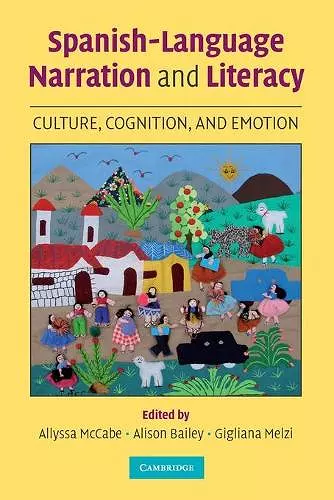Spanish-Language Narration and Literacy
Culture, Cognition, and Emotion
Alison L Bailey editor Allyssa McCabe editor Gigliana Melzi editor
Format:Paperback
Publisher:Cambridge University Press
Published:25th Aug '08
Currently unavailable, and unfortunately no date known when it will be back

Deepens our understanding of narration in Latino cultures, methods of thinking and expressing emotion, and implications for school achievement.
Examines how diverse groups of Spanish-speaking children in the Americas learn to express memories and stories, and ways their mothers and fathers assist them in this acquisition. This book deepens our understanding of narration in Latino cultures, their ways of thinking and expressing emotion, and implications for school achievement.This book is divided into three main topical sections: (1) Parent-child construction of narrative, which focuses on aspects of the social interaction that facilitate oral narrative development in Spanish-speaking children; (2) Developing independent narration by Spanish-speaking children; and (3) Narrative links between Latino children's oral narration and their emergent literacy and other school achievements. Chapters address narration to and by Latino children aged six months to eleven years old and in low, middle, and upper socioeconomic groups. Nationalities of speakers include the following: Costa Rican, Dominican, Ecuadorian, Mexican, Peruvian, Puerto Rican, Venezuelan, and Spanish-English bilingual children who are citizens or residents of the United States. Narratives studied include those in conversations, personal and fictional stories, and those prompted by wordless picture books or videos. Thus, the current project includes diverse nationalities, socioeconomic backgrounds, and genres of narrative.
“If you teach Spanish-speaking children or conduct research on language development, you’ll want to own this timely and relevant book. The ability to create oral narratives—for instance to tell someone what happened at the park—is a necessary foundation for literacy. But children learn to construct narratives as they interact with those around them, and what is included or emphasized in the narrative varies by culture. Spanish-speaking children are sometimes misinterpreted when they are actually producing narratives that are typical and appropriate in Peru or Guatemala or the Dominican Republic. The book provides information and interesting examples that can help teachers use Latino children’s distinctive narrative skills in a positive and rewarding way. Researchers will want to read the carefully designed studies that contribute materially to the literature on discourse development.” —Jean Berko Gleason, Boston University
"The research findings of the team assembled by Allyssa McCabe, Alison L. Bailey, and Gigliana Melzi open new vistas into the shaping of Latino culture through “talk” between caregivers and children. We become who we are through conversation. Our language is our identity. This is a scholarly contribution of the highest order!" —Ilan Stavans, author of Spanglish: The Making of a New American Language
ISBN: 9780521710046
Dimensions: 228mm x 152mm x 20mm
Weight: 530g
382 pages